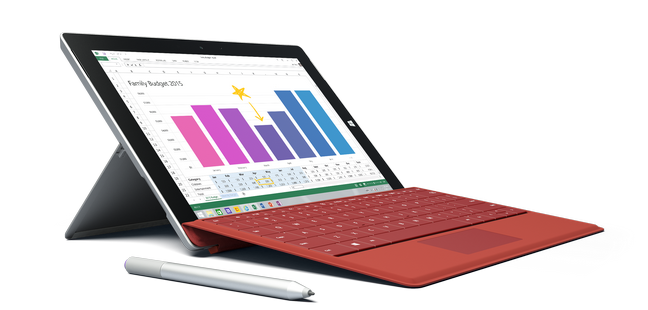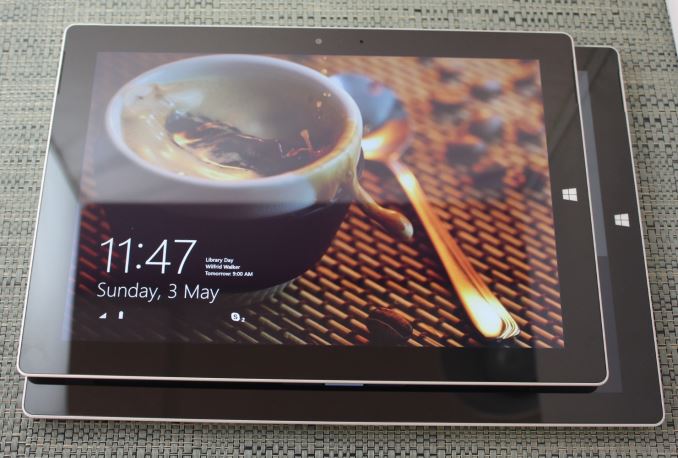Microsoft Confirms Surface 3 Production To End In December
by Brett Howse on June 24, 2016 6:25 PM EST
File this under “I’m not shocked” but Microsoft has confirmed today that the Surface 3 tablet will cease production by the end of December. The Surface 3 first launched way back in the spring of 2015, and after its review it quickly jumped to the top of the stack in the Windows tablet space. The design, excellent display, and 3:2 aspect ratio still makes it one of the best sub-$500 Windows tablets today.
So the news that it’s going to cease production in six months is not especially exciting – after all it will be going on two years old by that point. The real question is what is going to come next. The Surface 3 is a Cherry Trail Atom design, with a quad-core x7-8700 processor. The successor to Cherry Trail has been axed by Intel though, leaving a big gap in Intel’s lineup. They have confirmed that Apollo Lake will be available for tablet makers, but it’s certainly not a drop-in replacement for Cherry Trail.
Certainly this long after Surface 3 launched, there is plenty of room for improvement. USB-C has become more commonplace, and could easily replace the micro-USB charging which was a major hindrance on the Surface 3, leading to excessive charge times. One of the biggest issues with the Surface 3 was the sub-par storage performance, and on a new model it would be great to see NVMe based storage. The Surface 3 is also 50% thicker and heavier than the iPad Air 2, but it does have a built-in kickstand of course.
 Surface 3 on top of Surface Pro 3
Surface 3 on top of Surface Pro 3
We’ve not had any indication from Microsoft on a replacement device, so there’s no indication whether this model will be updated with a refreshed Surface 4, or just cancelled outright. The lack of a new Atom processor might force their hand. While it would be great to see this appear with a new Core M based part, unless Intel revamps that lineup, the pricing of that CPU would likely be the death knell of this smaller Surface device.
If you were looking at one of these, the 128 GB storage option also includes 4 GB of memory, and the price has dropped to $399/$449 without LTE. Stock is limited. It’s still one of the best Windows tablets around, despite its shortcomings.










63 Comments
View All Comments
Samus - Saturday, June 25, 2016 - link
I don't think there's any debate webos was better than android but where are the apps? At least android and iOS took the better parts of webos interface such as the card based task manager and synergy comm center in the form of pull down menu's.WebOS was no doubt a competitor, HP just fucked it all up so bad. Stupid Apothiker. Poor Palm. HP created the duopoly we have in the mobile market. Even if they hadn't bought Palm, someone else would have and provided the cash infusion they needed. It's really pocket change in the grand scheme of things...HP got Palm for like what, a billion dollars or so? That's nothing for what could have been a $20-$30 billion ecosystem.
Wolfpup - Monday, June 27, 2016 - link
I LOVED Palm OS. Don't know if WebOS was really a replacement, but I thought HP's first tablet was a lot better than the Android devices of the time.Impulses - Saturday, June 25, 2016 - link
I use my Nexus 7 (2013) daily still, if I didn't have it I might've bought a Surface 3 (or an NV Shield)... Some people don't need two dozen apps, 90% of my use is Chrome, that's it.Speedfriend - Monday, June 27, 2016 - link
And an iPad with its ridiculous blown up iphone home screen is somehow better?KPOM - Monday, June 27, 2016 - link
At least iPad apps are not just blown up iPhone apps.MonkeyPaw - Friday, June 24, 2016 - link
I wonder if Intel would be willing to make a Pentium M, based on skylake to fill in for Atom? I have a Surface 3, and it's darn near perfect for my needs. Thinner, USB-C and a faster system would be great.Alexvrb - Friday, June 24, 2016 - link
They already have Skylake based M processors. It remains to be seen if they're willing to scale one down in power and price enough to supplant Cherry Trail. Especially price... they're quite expensive compared to the Atoms... I would bet Intel won't play ball until (and if) a future low-power Zen chip challenges their control of high-end tablets.Roland00Address - Saturday, June 25, 2016 - link
You said: Especially price... they're quite expensive compared to the Atoms...No they are not, not really, sure atom is cheaper but not by much anymore. The die size of 22nm Baytrail T aka the z3770 was 101.87 mm2 with dimensions of 9.723 by 10.477. According to an official intel datasheet that was released after launch and intel purposefully burried this information where they rather be coy on die sizes.
Core M on 14nm Skylake has a die size of 98.5mm2
http://www.anandtech.com/show/9582/intel-skylake-m...
See page 307 the two numbers labeled c1 and c2. Note they put that info as table inside an image and never did OCR on that page to make it harder for people to find yet they had to reveal this info to their partners to some extent
http://www.intel.com/content/dam/www/public/us/en/...
In other words if yields on 14nm are the same as 22nm back in the day then core m on 14nm is cheaper to make than atom baytrail was to make on 22nm. This is due to the awesome power of moores law which may have slowed a bit but still applies where stuff should get cheaper over time.
Alexvrb - Saturday, June 25, 2016 - link
For your sake I hope you're kidding. First of all, we're talking about Cherry Trail in the Surface 3 (X7 Z8700). Not Baytrail. Cherry Trail is made on the same 14nm process. It's a bit smaller and it's lower power than even the smallest, lowest power Core m3 Skylake design. Second, pricing and cost to produce are two separate things. What Intel *CAN* sell it for and what they *WILL* sell it for are two completely different matters.Look at this straight from Intel.
http://ark.intel.com/products/88198/Intel-Core-m3-...
http://ark.intel.com/products/85475/Intel-Atom-x7-...
Pay close attention to pricing. I understand that this isn't necessarily the price MS would pay per unit, but the difference is staggering. Unless Intel decides to be really nice and start selling a neutered variant of the current m3 Skylake chip (perhaps with reduced clocks) for a LOT cheaper, there's simply no way it's going to be anywhere near Atom pricing. A Surface 4 with Skylake would cost as much as a Pro... which is why it's getting discontinued, for now.
Impulses - Saturday, June 25, 2016 - link
Wasn't this Intel's goal all along anyway? They kind of achieved it by mistake, but they brought Atom to life begrudgingly so VIA and others wouldn't stake a foothold in the netbook market... Then they sandbagged Atom for years because they didn't care to innovate in a low margins market that was stagnating anyway.Tablets and WinRT briefly made Atom relevant again, but now it's dead and no one seems to care. Maybe MS gave up on RT too soon, it was largely viewed as a power play for leverage, that worked... For all of two years, and now what?